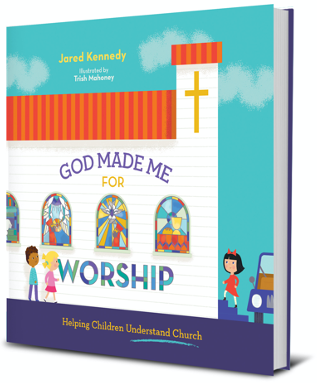Q & A About God Made Me for Worship
Understanding the different parts of a worship service can be confusing for a young child. One minute everyone is singing loudly, the next everyone is sitting and listening quietly. Sometimes the adults know something that should be said out loud, like, “Thanks be to God!” How did they know what to say? What is communion all about? And why does the pastor raise his hands and pray at the end of the service? In my new book, God Made Me for Worship: Helping Children Understand Church, I walk through the key movements of a worship gathering and explain them to kids. This bright, colorful children’s book illustrated by Trish Mahoney celebrates how Jesus’s story of redemption gives shape to our worship. Recently, New Growth Press director of publicity and social media, Audra Jennings, asked me to answer the following questions about why I wrote the book. Here is our conversation.
Not only do you work in children’s ministry, but you’re a dad to three children of your own. When did you start talking to your own kids about how we worship?
My oldest is fifteen now, so I have a hard time remembering her exact age, but I do know that the first conversations came up with our kids when they were in preschool and they’d get wiggly in services. In those times, our tendency was to hand them a piece of paper and pencil to draw or even a phone to play a game quietly. As a minister, I wasn’t satisfied with leaving it there. Even when they were young, I wanted to be intentional in teaching my girls the purpose behind all the parts of the worship.
Our middle daughter, Lucy, has a disability. She’s been diagnosed with severe Autism. We use social stories to teach her about new places and situations. We have little construction paper booklets with stick-figure drawings inside that walk her through all sorts of tasks like brushing her teeth and getting dressed for the day. We even made one once about the steps we’d take going on vacation—getting on a plane, staying at a hotel instead of home, going to Disney World and waiting in long lines, and seeing princesses.
God Made Me for Worship started out as my attempt to write a social story about attending church. But it’s not just the movements we go through each week. It also tells the reasons why behind each part of worship.
What parts of the worship service have you found children to be most confused about?
Anything new and different can be confusing for kids. Until recently in a lot of churches, kids would spend years in nursery and preschool children’s ministry classes, and they might not come to church with their parents at all until the elementary years. Many kids are used to a time of singing and teaching in children’s ministry, but any kind of call and response—or reciting the Lord’s Prayer perhaps or singing the Doxology—is more unfamiliar. When a kid encounters Communion for the first time, that’s also novel. A preschooler who is used to a goldfish snack each week in Sunday school might think, “This is snack time. Can I have a snack, too?”
You might be able to relate if you’ve attended a church that has a different style is belongs to a different tradition from your own. Growing up, my dad was part of the Gideons, and he would sometimes speak at churches to raise money for Bible distribution. I grew up as a Baptist, but I remember once attending the Lutheran church in our hometown when he spoke there. It was so different. I didn’t understand how to use the hymnal or how to follow along with the responsive readings. The kind Lutheran congregation knew we were visitors, and they were intentional about showing us what to do. They pointed out the numbers for the readings that were posted on the wall and told us which books to use. I want to help parents to be equally intentional with kids who transition from children’s-only gatherings to gathering with adults in the worship service. I want them to understand both what we do and why.
What are some of the questions the children ask Pastor Barnabas in God Made Me for Worship?
There are two big questions that kick off the story:
Why are there so many different parts to a worship service?
Why does it have to be so long?
You also include questions for the kids to get them thinking about their own experience in worship service. What kinds of questions do you ask them?
Here are a few simple ones.
What did you sing about God in church this week?
Is there a sin you need to confess today?
Who did you talk to during the welcome time at church this week?
What good news did you hear in the sermon? How does that good news change the way you live?
What is the best way to teach kids about worship?
The best way to encourage our kids to be responsive and expressive is by modeling it ourselves. Parents shouldn’t demand outward expression from their kids in worship, but they can encourage it. The Scriptures call everyone to clap their hands to the Lord. It’s a universal appeal (Ps. 47:1). So we should be clear with our children that God is calling them to respond to him as well.
Invite your kids to respond to God with their bodies by raising their hands in worship or bending their knees in prayer. the model these expressions yourself. Expressive joy in Christ makes his message believable for our kids.
The church was established in Acts, so we usually look to the New Testament as a guide to worship—after all, we don’t have to bring sacrifices like the Israelites of the Old Testament. However, you go to Isaiah 6 as the inspiration. Why is that?
The reason takes us back five hundred years to the Reformation. During the birth of the Protestant church, John Calvin saw a need to help the church rehearse the good news of the gospel every time it gathered for worship. His liturgy—his order of service—was drawn from a few key Bible passages, and an important one for him was Isaiah 6. Following Isaiah’s vision of God in heaven, the service begins by adoring God for being the great and holy one just. He began with a call to worship and songs of praise. What follows is a prayer confession that we are sinful and our world is broken—just like Isaiah’s confession, “I am a man with unclean lips and I live among people with unclean lips.” Next, there’s the good news that our sins are atoned for and forgiven. Then, Isaiah’s vision closes like our worship services do, with a benediction that sends us out on mission into the world.
The pandemic this year has changed the ways many congregations have had to structure their worship services. Does the current situation make it easier or harder to explain why and how we worship?
In many churches—often because of government restrictions—children’s ministries have stayed closed longer than the adult gatherings. If kids are coming to services, they’re sitting in church with mom and dad. I think what many parents have discovered is that having young kids with you in worship is really hard. Other families may not have returned to church at all—perhaps because a child is immunocompromised and at-risk or because mom and dad don’t have a clear conscience about bringing their kids out into crowds (After all, Johnny just won’t keep his mask on!). The truth is that being in worship right now is harder for all of us. Singing with a mask on is no fun, and the welcome time just isn’t the same. Goodness, I know that the huggers out there are going to be on a mission when this thing is over.
But I think we need to see the difficulty we’re experiencing now as an opportunity. When you keep on prioritizing worship with the church (whether in-person or via live stream) even though it’s hard, you’re showing your kids that it’s important. And it doesn’t hurt to slow down and tell them, “By the way, this is why it’s important.”
Each book in the God Made Me Series includes a section to help parents continue having conversations with their kids. What tips and encouragement do you offer parents at the end of God Made Me for Worship?
At the back of the book, I write about Psalm 145. Verse 4 of that passage says, “One generation commends God’s works to another.” That’s our job as moms and dad: to tell the next generation our testimony, to tell them all of the wonderful things God has done for us.
A few simple ways to do that include slowing down to say thanks for what God has given you. Also, to examine your heart and how often you complain. Then, put off complaining and put on a life of praise.
What are some ways families can incorporate worship in daily life?
The best way is to read God’s Word and pray together regularly as a family. One additional thing you might try is to explain a common worship practice with your kids. You could use God Made Me for Worship or pick another worship practice that is common in your church community like giving (2 Cor. 9:6–14) or lifting hands in prayer (1 Tim. 2:8) or playing instruments (Ps. 98). Lookup a passage in the Bible and then talk with your kids about how this rhythm of worship looks in your church community.
God Made Me for Worship isn’t your only new book. Tell us a little bit about your other new release, Jesus Came for Me.
Thanks for asking, Audra. Jesus Came for Me is a new board book in the Beginner’s Gospel Story series. The book helps toddlers and preschoolers understand the true meaning of Christmas in a personal and memorable way. It begins with the announcement of John the Baptist’s birth to Zechariah and ends with the visit of the wise men. Jesus, our great God, was born as a little baby, and his birth is good news and great joy for all people—including children! My prayer is that this book will help moms and dads share the true meaning of Christmas with their kids this season.
Both God Made Me for Worship and Jesus Came for Me are available now from New Growth Press.
Thanks, Audra, for asking such great questions. I pray these resources are helpful for families.

